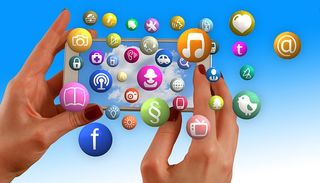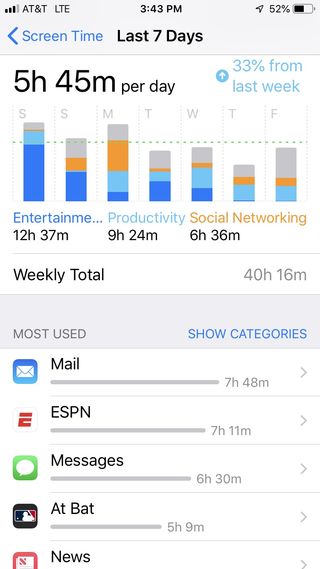
If you are reading this post I am sure that you have been seeing confusing, contradictory and often scary headlines such as the following on what seems like a daily basis:
- The Sad State of Happiness in the United States and the Role of Digital Media
- Plugged in: Americans spend an average of 5.4 HOURS a day on their phones - and both Millennials and Baby Boomers spend most of their time on Facebook and Instagram
- Is Screen Time Before Bed REALLY Bad For Kids? Controversial Study Claims Teenagers Who Regularly Use Smartphones And Tablets Are NOT At Risk Of Damaging Their Mental Health
- Snap Has a New Plan For Taking Over Teens’ Lives
Three things in these articles trouble me. First, how are they measuring screen time when the phone is rarely used for any length of time at one sitting? Second, how can studies assert the impact of “screen time” without talking about what we are doing during that screen time? Third, how scary is it that app developers such as Snap are designing and constantly re-designing their apps to direct teens (and adults) to spend more of their screen time in less-than-productive activities. [NOTE: I am not saying that using Snap is unproductive, but check out their new changes and judge for yourself if screen time might be better used elsewhere or perhaps turned into offline time.]
Screen time is a tricky issue. Research has shown that most people underestimate how much time they spend on their phones. In our work we have participants put an app on their phone that monitors daily hours using the phone and number of times it is unlocked each day and we also ask them self-report questions about their phone use. The app data and self-report data are barely correlated. After collecting data for 5 or more weeks we ask if the numbers they are getting are less than expected, the same as expected or more than expected. Most say “more than expected.” And quite honestly I am not surprised. When you watch someone on a smartphone they will tap an icon, spend a few moments to maybe a minute or so and then tap another icon. Our latest data suggests that they unlock their phone 70+ times a day and use it for a few minutes each time and then close it back up. If you ask them how many hours a day they spend on their phone it is very difficult to piece together a minute here, two minutes there and so they underestimate their usage. If you read the first three articles linked at the top of this blog you will see that they are relying on self-report measures of daily screen time including having some participants keep a one-day diary.
But even if those numbers are even close to accurate the results are suspect because all screen time is not the same.

For example, according to my iPhone’s Screen Time app, over the last 7 days, I averaged 5.75 hours a day on my phone. However, when I look at the specific apps that I used during my 40 hours this last week I discovered that I spent 12 hours on my ESPN and At Bat apps (I watched three Dodger games), almost 8 hours on email (yeah, that’s my poison—but I get hundreds per day and prefer a clean inbox), and 6.5 hours on iMessage. That one troubled me until I investigated and realized that if you have an app open on the screen, but are not actively using it, Screen Time still counts the time. I text multiple family members and am part of several group texts and often leave iMessage open so it vibrates instead of constantly beeping. Of my 168 notifications during the week 114 were iMessages. And I only unlocked my phone 41 times a day. That doesn’t sound as though I am using my phone for anything that might be psychologically harmful (unless you count a Dodger loss) yet 5 ½ daily hours is right up there in the potential psychological danger zone according to the first article above.
So, screen time, as a gross measure, may be both inaccurate and limited in its information. In our most current work we have participants use the Moment app, which only counts time when you are actively using an app, to give us the gross numbers for daily unlocks and minutes and Screen Time’s 7-day report and Moment’s battery activity function for a more granular look at the distribution of time even though the data may be somewhat distorted. Sadly, both of those require multiple screenshots, which make them unwieldy for research purposes. Hopefully, someone will figure out how to allow the user to download those app use data directly rather than through screenshots.
My third concern is something I have written and spoken about extensively: App design that attempts to garner and hold our attention. The 60 Minutes segment on Brain Hacking brought this issue to the forefront as it aired twice to more than 22 million viewers; 350,000 people have viewed the YouTube video. The Center for Humane Technology is the place to go for more information on this issue. The bottom line is that app developers hire behavioral scientists to help them make their apps so attractive that they are irresistible. This includes designing the app’s icon with attractive colors and other enticing features, adding components to the app that will keep users there longer (e.g., gamification) and including features that will encourage (entice) users to return time and time again (such as streaks on Snapchat). I have many issues with these design decisions for young people but am also concerned when they are unleashed on adults such as encouraging Words With Friends players to maintain streaks with their opponents to get them to play at least once a day. When it comes to apps that are used primarily by younger people, such as Snapchat as discussed in the article above, I have serious reservations.

The prefrontal cortex of the brain drives executive functions including directing attentional resources as well as controlling impulsivity. However, the PFC is not completely formed until someone is in his/her mid-to-late 20s at best. This means that preteens, teens and young adults are at the mercy of app developers who want to direct their attention to their app and keep it there. This is not good.
What can be done about this problem? My take is that it has to be a three-part solution that involves users, parents and the educational system. The educational system should be responsible for teaching media literacy starting with very young children at their developmental level and continuing along developmental stages through high school. There are good programs out there and a Google search will provide numerous choices. Parents need to guide and control their children’s use of technology. They need to know what apps their child or teenager is using and actively engage with those apps to make sure they are not using psychological tools to grab attention. Parents also need to view their child’s daily usage through one of the built-in apps and check how often they are unlocking their phones and what apps they are using. I'm not talking about helicopter parenting—I'm talking about technological vigilance, which is becoming even more important as the “attention merchants” are ramping up their efforts to keep the kids (and young adults) hooked.
Finally, users of all ages, but particularly those who still have a developing prefrontal cortex, need to pay attention to their daily and weekly smartphone use by examining data from Screen Time for iPhone users or Digital Wellbeing for Android users. And users need to become more aware of the impact of excessive screen time and of the efforts of tech companies to hijack their attentional resources. I recommend they start by watching the 60 Minutes “Brain Hacking” segment and then visit the Center for Humane Technology for further information.
I consider myself an optimist, but I am having trouble feeling optimistic about any of these issues. Our current research has users making modifications to their smartphones to enhance their usage and may provide some clues to avoiding problems and perhaps restore my optimism.




